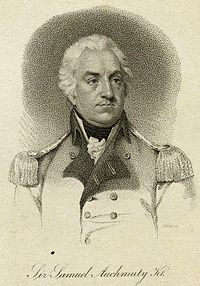
José Gervasio Artigas Arnal was a soldier and statesman who is regarded as a national hero in Uruguay and the father of Uruguayan nationhood.

The Argentine War of Independence was a secessionist civil war fought from 1810 to 1818 by Argentine patriotic forces under Manuel Belgrano, Juan José Castelli, Martin Miguel de Guemes and José de San Martín against royalist forces loyal to the Spanish crown. On July 9, 1816, an assembly met in San Miguel de Tucumán, declaring independence with provisions for a national constitution.

Major-General Robert Craufurd was a British officer. After a military career which took him from India to the Netherlands, in 1810 in the Napoleonic Peninsular War he was given command of the Light Division, composed of the elite foot soldiers in the army at the time, under the Duke of Wellington. Craufurd was a strict disciplinarian and somewhat prone to violent mood swings which earned him the nickname "Black Bob". He was mortally wounded storming the lesser breach in the Siege of Ciudad Rodrigo on 19 January 1812 and died four days later.

The Viceroyalty of the Río de la Plata meaning "River of the Silver", also called the "Viceroyalty of River Plate" in some scholarly writings, in southern South America, was the last to be organized and also the shortest-lived of one of the viceroyalties of the Spanish Empire in the Americas. The name "Provincias del Río de la Plata" was formally adopted in 1810 during the Cortes of Cádiz to designate the Viceroyalty of the Río de la Plata.

Santiago Antonio María de Liniers y Bremond, 1st Count of Buenos Aires, KOM, OM was a Spanish military officer and a viceroy of the Viceroyalty of the Río de la Plata. Although born Jacques de Liniers in France, he is more widely known by the Spanish form of his name.

The British invasions of the River Plate were two unsuccessful British attempts to seize control of the Spanish colony of the Viceroyalty of the Río de la Plata, located around the Río de la Plata in South America – in present-day Argentina and Uruguay. The invasions took place between 1806 and 1807, as part of the Napoleonic Wars, War of the Third Coalition at a time when Spain was an ally of Napoleonic France. In Argentine historiography, the two successive defeats of the British expeditionary forces are known collectively as the "Reconquista" and the "Defensa", respectively.

The Rifle Brigade (The Prince Consort's Own) was an infantry rifle regiment of the British Army formed in January 1800 as the "Experimental Corps of Riflemen" to provide sharpshooters, scouts, and skirmishers. They were soon renamed the "Rifle Corps". In January 1803, they became an established regular regiment and were titled the 95th Regiment of Foot (Rifles). In 1816, at the end of the Napoleonic Wars, they were again renamed, this time as the "Rifle Brigade".
Banda Oriental, or more fully Banda Oriental del Río Uruguay, was the name of the South American territories east of the Uruguay River and north of Río de la Plata that comprise the modern nation of Uruguay, the modern state of Rio Grande do Sul, Brazil, and part of the modern state of Santa Catarina, Brazil. It was the easternmost territory of the Viceroyalty of the Río de la Plata.
The 38th Regiment of Foot was an infantry regiment of the British Army, raised in 1705. Under the Childers Reforms it amalgamated with the 80th Regiment of Foot to form the South Staffordshire Regiment in 1881.
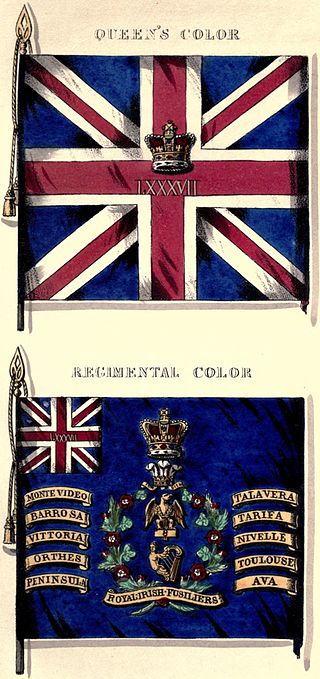
The 87th Regiment of Foot was an infantry regiment of the British Army, raised in 1793. Under the Childers Reforms it amalgamated with the 89th Regiment of Foot to form the Princess Victoria's in 1881.
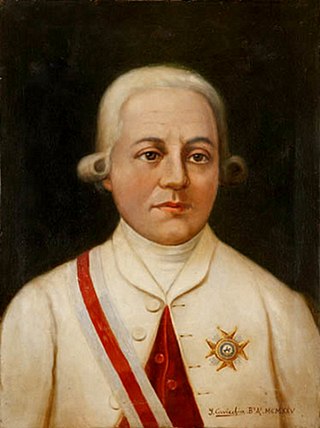
Don Rafael de Sobremonte y Núñez del Castillo, 3rd Marquis of Sobremonte, third Marquis of Sobremonte, was an aristocrat, military man and Spanish colonial administrator, and Viceroy of the Río de la Plata. He was accused of cowardice by the people of Buenos Aires after escaping the city during the British invasions of the Río de la Plata in 1806.
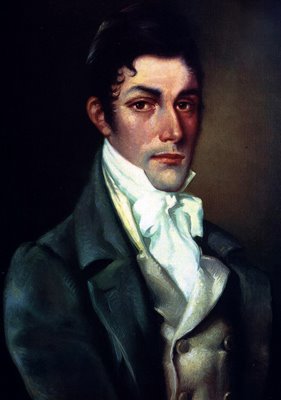
Martín de Álzaga was a Spanish merchant and politician during the British invasions of the Río de la Plata.

Pascual Ruiz Huidobro, was a Spanish soldier in the Viceroyalty of the Río de la Plata, who fought against the British invasions of the Río de la Plata as Governor of Montevideo.
Sir Edward Gerald Butler was an Irish soldier.

The Battle of Cardal, on 20 January 1807, was the main conflict between the Spanish defense forces of Montevideo, Uruguay, and British troops during the siege of Montevideo during the second British invasion of the River Plate. The British won an easy victory over the outnumbered opposing forces, which paved the way for the fall of the city,
Juan Ángel Michelena was a Spanish Navy officer and colonial administrator who served in the French Revolutionary and Napoleonic Wars and the Argentine War of Independence. He also served as acting governor of Montevideo. He maintained his loyalty to the Spanish Empire during the Argentine War of Independence. In 1825, Juan Ángel Michelena was designate as governor of Ferrol, Galicia.

Plaza de Toros del Retiro was a bullfighting coliseum of Buenos Aires of the 19th century. This Arena was established in the city during the last years of the colonial period.
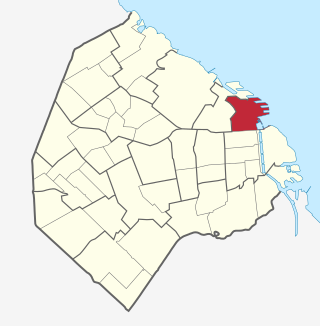
Battle of the Retiro was a battle produced during the second British Invasion of the Río de la Plata, between the Spanish troops, led by Santiago de Liniers, and the British forces under John Whitelocke.

The action of 2 June 1807 was an engagement during the British invasions of the River Plate between a British Royal Navy schooner and two Spanish small vessels, a privateer sloop and a felucca, at the mouth of the Paraná Guazú river. The encounter took place when the British warship, assisted by two armed boats, was searching for Spanish shipping off Punta Gorda, in the mouth of the Uruguay river.
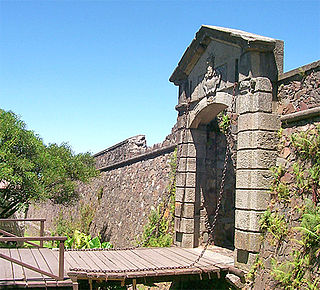
The Battle of Colonia del Sacramento took place in the night of 21/22 April 1807, during the British invasions of the River Plate. A force of 1,500 militias led by Colonel Francisco Javier de Eíío was repelled by 1,000 British infantry and cavalry troops holding the fortress of Colonia del Sacramento and commanded by Colonel Dennis Pack.

